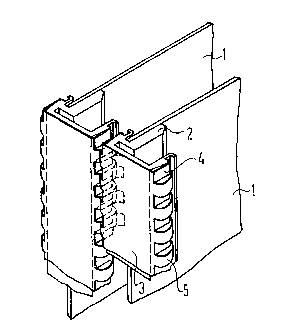Une partie des informations de ce site Web a été fournie par des sources externes. Le gouvernement du Canada n'assume aucune responsabilité concernant la précision, l'actualité ou la fiabilité des informations fournies par les sources externes. Les utilisateurs qui désirent employer cette information devraient consulter directement la source des informations. Le contenu fourni par les sources externes n'est pas assujetti aux exigences sur les langues officielles, la protection des renseignements personnels et l'accessibilité.
L'apparition de différences dans le texte et l'image des Revendications et de l'Abrégé dépend du moment auquel le document est publié. Les textes des Revendications et de l'Abrégé sont affichés :
| (12) Demande de brevet: | (11) CA 2018457 |
|---|---|
| (54) Titre français: | DISPOSITIF DE BLINDAGE POUR SYSTEMES ELECTRIQUES |
| (54) Titre anglais: | SHIELDING APPARATUS FOR AN ELECTRICAL ASSEMBLY |
| Statut: | Réputée abandonnée et au-delà du délai pour le rétablissement - en attente de la réponse à l’avis de communication rejetée |
| (51) Classification internationale des brevets (CIB): |
|
|---|---|
| (72) Inventeurs : |
|
| (73) Titulaires : |
|
| (71) Demandeurs : |
|
| (74) Agent: | SMART & BIGGAR LP |
| (74) Co-agent: | |
| (45) Délivré: | |
| (22) Date de dépôt: | 1990-06-07 |
| (41) Mise à la disponibilité du public: | 1990-12-09 |
| Licence disponible: | S.O. |
| Cédé au domaine public: | S.O. |
| (25) Langue des documents déposés: | Anglais |
| Traité de coopération en matière de brevets (PCT): | Non |
|---|
| (30) Données de priorité de la demande: | ||||||
|---|---|---|---|---|---|---|
|
ABSTRACT OF THE DISCLOSURE
Shielding apparatus for an electrical assembly. A
shroud that covers a front cover of the assembly is
located at the front side of the electrical assembly that
is insertable into a magazine. The shroud is snapped
onto the front cover with retaining tabs and has
laterally resilient contact tabs that are contacted by
contact tabs of neighboring shrouds. As a result, the
shrouds are directly connected to one another, so that
only one electrical function between the shielding parts
is established per assembly. In particular, the
shielding effect is so effective that the shrouds can be
utilized in radio-frequency electrical systems.
Note : Les revendications sont présentées dans la langue officielle dans laquelle elles ont été soumises.
Note : Les descriptions sont présentées dans la langue officielle dans laquelle elles ont été soumises.

2024-08-01 : Dans le cadre de la transition vers les Brevets de nouvelle génération (BNG), la base de données sur les brevets canadiens (BDBC) contient désormais un Historique d'événement plus détaillé, qui reproduit le Journal des événements de notre nouvelle solution interne.
Veuillez noter que les événements débutant par « Inactive : » se réfèrent à des événements qui ne sont plus utilisés dans notre nouvelle solution interne.
Pour une meilleure compréhension de l'état de la demande ou brevet qui figure sur cette page, la rubrique Mise en garde , et les descriptions de Brevet , Historique d'événement , Taxes périodiques et Historique des paiements devraient être consultées.
| Description | Date |
|---|---|
| Inactive : CIB de MCD | 2006-03-11 |
| Le délai pour l'annulation est expiré | 1998-06-08 |
| Demande non rétablie avant l'échéance | 1998-06-08 |
| Inactive : Abandon.-RE+surtaxe impayées-Corr envoyée | 1997-06-09 |
| Réputée abandonnée - omission de répondre à un avis sur les taxes pour le maintien en état | 1997-06-09 |
| Demande publiée (accessible au public) | 1990-12-09 |
| Date d'abandonnement | Raison | Date de rétablissement |
|---|---|---|
| 1997-06-09 |
Les titulaires actuels et antérieures au dossier sont affichés en ordre alphabétique.
| Titulaires actuels au dossier |
|---|
| SIEMENS AKTIENGESELLSCHAFT |
| Titulaires antérieures au dossier |
|---|
| EDUARD MAIR |
| INGEBORG BUSSE |
| PETER SEDLMEIER |